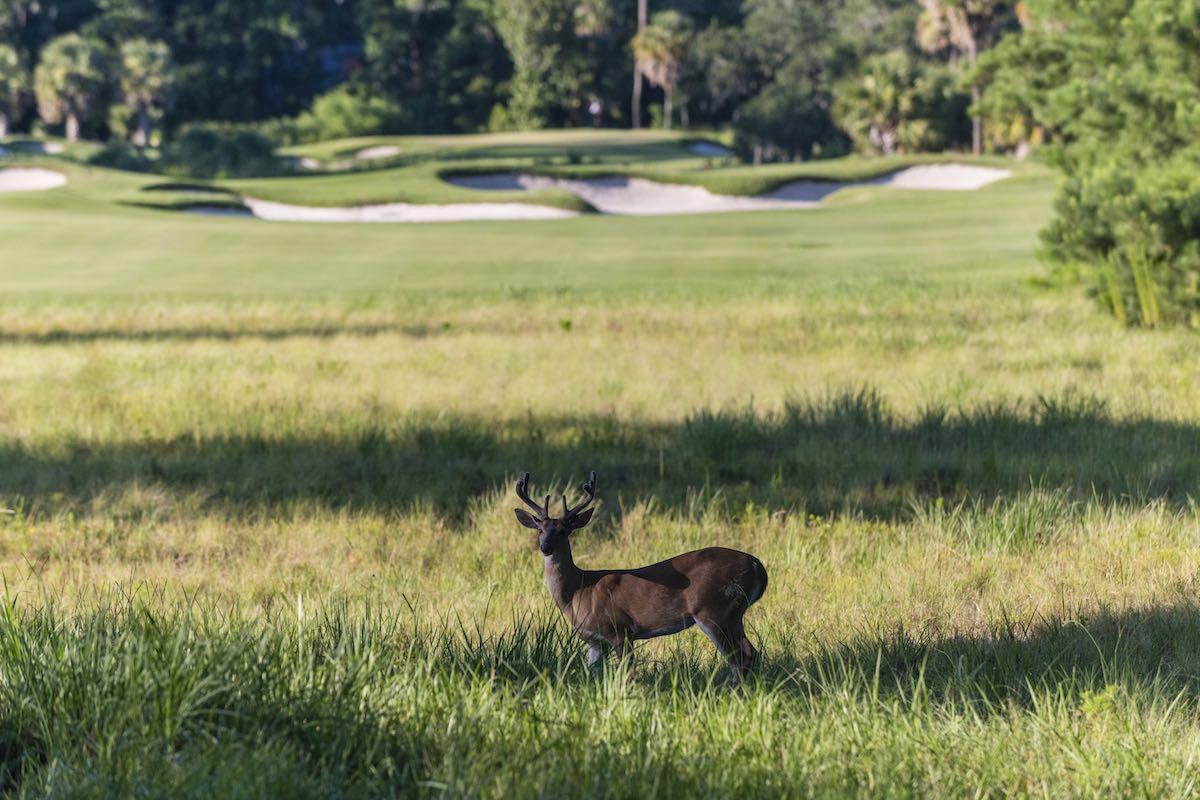Palmetto Bluff Real Estate Company Sales Office
Office Hours
Monday-Friday 9am - 5pm
Saturday 9am - 4pm
Sunday 12 - 4pm
Saturday 9am - 4pm
Sunday 12 - 4pm
For visitors and residents of the Bluff, the Conservancy’s new Reading Room at Moreland Village offers a relaxing place to discover more about the Lowcountry. Guidebooks identify native coastal plants and animals and history texts reveal a fascinating past of the area. There’s also a new display space where changing exhibits provide more details of the ecology, history, and culture of this special place and where, right now, fossils tens of thousands of years old reveal that Palmetto Bluff was once a very different place than it is today.
Mastodons, giant ground sloths, and saber-toothed cats may not be the wildlife that comes to mind when you think of the Bluff, but at the peak of the last ice age—21,000 years ago—these animals were right at home in South Carolina. And that home would have been unrecognizable to modern inhabitants: at Palmetto Bluff, the tidal estuaries and maritime forest that surround us were thousands of years in the future. In fact, because so much water was frozen into glaciers and snow, the sea level was much lower and a vast stretch of the continental shelf of North America was exposed. The marshes and waters of the Atlantic lay 100 miles east of what is now Wilson Village.
Evidence of the Bluff’s ice age ecosystem can be found at the bottom of the Savannah River and in nearby estuaries where currents and tidal action have exposed concentrated deposits of fossils. Although visibility in these waters is often two feet or less, local diver Doug Duch has managed to find hundreds of teeth and bones from the prehistoric beasts that once roamed the Lowcountry. These fossils, some of which are on display in the Reading Room, are consistent with what paleontologists elsewhere in the Southeast have found and reveal that despite the global cooling during the last ice age (150,000 to 11,000 years ago), South Carolina had a warm subtropical climate. For example, the mammoths that roamed the Bluff weren’t the woolly mammoths that wandered the tundra near the edge of the ice sheets. Instead, this was home to the Columbian mammoth, which stood about 13 feet tall, two feet taller than its northern cousin. (Woolly mammoths were about the size of African elephants, nine to 11 feet tall.) And Columbian mammoths weren’t woolly, they didn’t need thick fur because here, if the temperature ever dipped below freezing, it didn’t stay there for very long. In fact, animals such as capybaras and giant tortoises, animals that no longer live in South Carolina but continue to thrive in the tropics, flourished in the mild climate of the ice age Lowcountry.
The fossils recovered from the rivers provide more than just a list of the animals that once lived here; they also provide details of the ancient habitat. Mammoths, bison, and wild horses are grazing animals whose diets consist of a high percentage of grasses. The large number of fossils of these grazers (and fossil pollens from other locations) indicates that vast grasslands or savannas covered much of South Carolina’s ancient coastal plain. On the other hand, mastodons primarily ate the seeds, leaves, and even small branches of shrubs and trees, as well as grasses and sedges. The presence of mastodon fossils corroborates botanical studies that indicate patches of forests and copses along the wetlands broke up the expanse of grasslands.
Although fierce predators such as saber-toothed cats, jaguars, American lions, and dire wolves stalked the large herbivores of the ice age, it was the combination of changing climate and human hunting that caused the extinction of these animals and their predators. In Alaska, the lower sea level during the ice age exposed an isthmus—the Bering Land Bridge—that connected western Alaska to eastern Russia. Hunter-gatherers who had lived in Asia for millennia took advantage of the new connection and became the first people (called Paleoindians by archaeologists) in the Americas around 23,000 years ago. It is likely that the earliest arrivals moved south along the coast, fishing and hunting near the shore. Eventually, as groups reached the southern edge of the great ice sheets, some moved inland, spreading into North America and down into South America.
By 12,000 years ago, Paleoindians were hunting the savannas of Palmetto Bluff. Here, characteristic stone tools reveal the presence of these ancient visitors.
By the time the Paleoindians arrived at Palmetto Bluff, the ice age was ending. Warmer temperatures melted the enormous glaciers that covered the northern and southern ends of the earth and the sea level was rising. Over the next 60 centuries, the sea would continue to rise until about 6,000 years ago, when the coastline was much like that of today; the May River flowed with the tides, the New River brought freshwater from wetlands to the sea, and live oaks, longleaf pines, and palmettos grew up in what had once been grasslands. And now, centuries later, it is our turn to enjoy this spectacular place.
Braving the depths and the dark…
Doug Duch has been diving in the waters around Savannah about twice a month for nearly 20 years. Summer dives are in comfortable, warm waters, but sometimes even with an underwater light, Duch has to rely more on feel than sight to locate fossils because the water is so murky. Occasionally, visibility can be as much as six feet in winter, when the water has less organic matter, but cold temperatures require that divers wear considerable protective gear.
Diving in any season requires careful timing because of the tidal currents that change in direction and strength throughout the day. Duch plans his dives, which last about two hours or so (two tanks of air), for a time when the tides are just changing from high to low or vice versa. This is when the relatively quiet waters allow him to focus on hunting for fossils rather than struggling to maintain his position in the estuary.
A typical dive by Duch yields dozens of fossils. In the photo above, along with the remains of ancient horses, whales, and mastodons, are teeth from what many scientists believe was the deadliest predator of the seas that ever lived: the 50-foot-long sharks commonly called megalodons. These ferocious creatures, over twice the size of today’s great white sharks, had actually been extinct for over two million years by the time the last ice age began.%GALLERY%SIDE BAR:
Mammoths & Mastodons
Although similar in appearance, mastodons and mammoths are actually only distant relatives. (Mammoths are more closely related to modern elephants than they are to mastodons.) Mastodons were smaller, about the same size as an elephant, and their tusks were less curved. Mastodons browsed on leaves, twigs, and seeds of shrubs and trees while mammoths grazed on grasses. This difference in diet meant that mammoths and mastodons occupied different niches in the same ecosystem.
American Lions
The southeastern United States of the ice age would have resembled the African savanna in many ways, with herds of buffalo and elephant-like mammoths and prides of lions. The American lion was similar to the African lion in shape, but it was about 25 percent larger. Its brain-to-body ratio was also higher, indicating that it may have been more intelligent as well. (Some scientists have suggested the fact that only a few lion skeletons have been found in the La Brea Tar Pits in California indicates that American lions were clever enough to recognize the tar pits as a danger.)
Arrows
South Carolina was populated with large land animals, such as giant sloths, American lions, and mammoths, that disappeared as the ice age ended. The changing environment may have caused some changes in the ranges of these animals, but many researchers now believe that Paleoindian hunters, who arrived in the Southeast about 13,000 years ago, were largely responsible for the extinction of most of the American megafauna (large animals).
By: Dr. Mary Socci
Photography by: Krisztian Lonyai / Drawings by Alex Coppola

Tis’ the season for wrapping, and we have plenty of gifts to share from 2024! This year was filled with exciting new beginnings and continued growth at Palmetto Bluff. From two new golf courses to awards for both Montage Palmetto Bluff and FLOW...

Photos courtesy of Leah Bailey DesignPhoto credit: Kelli Boyd PhotographyAs the holiday season descends upon the Lowcountry, Palmetto Bluff becomes a festive haven, where classic Southern architecture meets personal style. Whether you prefer timeless elegance ...

Executive Chef Beth Cosgrove and Registered Dietician Lindsay Ford recently led a Healthy Cooking Demonstration for residents interested in cooking healthy, delicious food to promote wellness. Attendees left with new recipes and flavors to try at home. The But...

Photographs by Anne CaufmannStory by Barry Kaufman The story of this house begins with another.Mike and Melissa Pereyo first visited Palmetto Bluff in 2010 to visit longtime friends Butch and Debbie Floyd. The Floyds built their home here when the fringes of t...

How to Spend a Lowcountry Christmas at Palmetto Bluff There's no better way to start anticipating the holidays than by making plans to spend time with family and friends. Now that the holiday season has arrived, many look forward to embracing the Christmas sp...

Explore 130 August Lane at Montage Residences Nestled in the heart of the Lowcountry, the Montage Residences at Palmetto Bluff offer an unparalleled blend of elegance, exclusivity, and Southern charm. This private collection of homes sits amidst the lush land...

Experience Winter Wildlife This Season at Palmetto Bluff The Lowcountry is a wondrous place to live, not only for its breathtaking scenery and historical significance but also for the wildlife that inhabits it. Winter wildlife in South Carolina includes a wid...

As summer’s heavy air fades into fall’s cool breezes, our resident wildlife are busy preparing for another Lowcountry winter.In the fall, eastern wild turkeys move into habitats mostly dominated by hardwood trees such as oaks, hickories, beeches, cypresses, tu...

The Arts Initiative at Palmetto Bluff hosted an unforgettable evening in the May River Chapel this past October with our visiting Artist in Residence, multi-Grammy-winning singer-songwriter Clay Ross, founding member of the Billboard chart-topping band Ranky T...

This year’s FLOW FEST was an unforgettable celebration of art, music, and community spirit. Held on a stunning autumn afternoon by the May River, our third annual arts and music festival, hosted by The Arts Initiative at Palmetto Bluff, brought together friend...
Learn about the Palmetto Bluff Conservancy and how we keep the vision of our land in place.
On land or water, there is an ever-evolving variety of activities.
We do not attempt to independently verify the currency, completeness, accuracy or authenticity of the data contained herein. All area measurements and calculations are approximate and should be independently verified. Data may be subject to transcription and transmission errors. Accordingly, the data is provided on an “as is” “as available” basis only and may not reflect all real estate activity in the market”. © [2023] REsides, Inc. All rights reserved. Certain information contained herein is derived from information, which is the licensed property of, and copyrighted by, REsides, Inc.